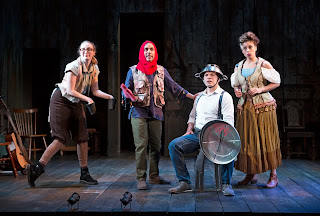
Children of Abraham: Shared Pathways = Rose of the Compass and The Cathedral Choir of St. John the Divine = April 2024 = On April ninth, St. John The Divine, the magnificent cathedral in NYC, presented a programme titled Children of Abraham: Shared Pathways . Rose of the Compass joined The Cathedral Choir of St. John the Divine in the nave of the cathedral performing music — traditional and contemporary — in the Christian, Judaic and Islamic traditions. The name of the Chorus is self-explanatory; its conductor is Kent Tritle. Rose of the Compass is a world/early music ensemble founded by Nina Stern, the ensemble’s director. Its instruments that evening were: recorders and their cousin, the chalumeau; oud; cello; Turkish kanun (a large zither with 26 courses of strings); percussion made up of drums and bells. 19 short pieces — almost exclusively devotional music — were classed into three titled sets: Longing for Peace , The Dance of Life ; Celebration of Common...





